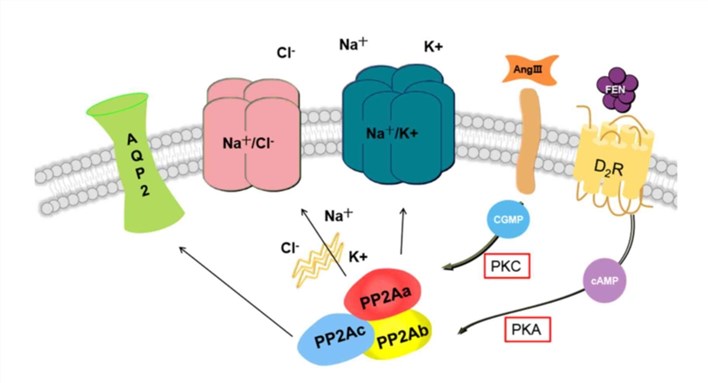What is PPP2CA Protein
The PPP2CA protein, officially known as Protein Phosphatase 2 Catalytic Subunit Alpha, is a key player in cellular processes, wielding its influence over various biological functions. Also referred to as PP2A-alpha, this protein belongs to the phosphatase family, specifically the PP2A subfamily. Its structural characteristics and classification position it as a critical component in cellular regulation.
PPP2CA Protein Structural Characteristics and Classification
PPP2CA possesses a distinctive structure that underlies its functional significance. It is composed of a catalytic domain, regulatory A and B subunits, and a well-defined C-terminal tail. The catalytic domain is responsible for its enzymatic activity, facilitating the dephosphorylation of target substrates. The A subunit governs the assembly of the holoenzyme, while the B subunit directs substrate specificity. This structural intricacy showcases the protein's ability to orchestrate precise cellular responses.
Recent research has shed light on PPP2CA's multifaceted role in cellular dynamics. Advances in structural biology techniques have elucidated finer details of its catalytic mechanism, providing a molecular-level understanding of its function. Moreover, studies exploring its interactions with regulatory subunits have unveiled the intricate regulatory networks that dictate its activity.
PPP2CA Biological Functions and Molecular Mechanisms
PPP2CA is a linchpin in cellular signaling cascades, exerting control over diverse biological processes. Its primary function revolves around dephosphorylation – the removal of phosphate groups from proteins. This activity, crucial for cellular homeostasis, regulates the activation states of various proteins, impacting cellular proliferation, apoptosis, and differentiation.
At the molecular level, PPP2CA acts as a phosphatase that counterbalances the actions of protein kinases. Kinases add phosphate groups to proteins, a modification that often activates them. PPP2CA, by contrast, acts as a molecular switch, deactivating these proteins through dephosphorylation. This delicate equilibrium between kinases and PPP2CA ensures precise control over cellular processes.

Figure 1. Renal PP2A targets various ion-transport proteins and AQP2. (Shao L, et al., 2021)
PPP2CA Related Signaling Pathway
PPP2CA is an integral component of several signal transduction pathways, modulating their outcomes through precise dephosphorylation events. One notable pathway is the PI3K/Akt/mTOR cascade, where PPP2CA regulates the activity of Akt by dephosphorylating critical residues. This regulatory role influences cell survival, growth, and metabolism, emphasizing the protein's centrality in cellular decision-making.
PPP2CA Related Diseases
Dysregulation of PPP2CA has been implicated in various diseases, emphasizing its significance in maintaining cellular health. Aberrant PPP2CA activity has been associated with cancer, neurodegenerative disorders, and cardiovascular diseases. In cancer, for instance, altered PPP2CA levels contribute to uncontrolled cell growth and survival, highlighting its potential as a therapeutic target.
PPP2CA's Applications in Biomedicine
- Diagnostic Development
PPP2CA's involvement in diseases makes it a potential biomarker for diagnostic purposes. Monitoring its expression or activity levels could provide valuable insights into disease progression and aid in early detection. Diagnostic assays targeting PPP2CA may offer a non-invasive means of assessing disease status.
- Vaccine Development
Understanding PPP2CA's role in immune regulation opens avenues for vaccine development. Harnessing its immunomodulatory functions could enhance vaccine efficacy by fine-tuning immune responses. Researchers are exploring ways to incorporate PPP2CA-related insights into vaccine design to bolster protective immunity.
- Therapeutics
Given its involvement in diseases, PPP2CA emerges as a promising therapeutic target. Small molecules or biologics that modulate PPP2CA activity could be developed to restore cellular balance in diseases characterized by dysregulated phosphorylation. This approach holds potential for precision medicine, allowing tailored interventions based on the specific molecular alterations in a patient's cells.
Recommended Products
| Cat.# | Product name | Species | Source (Host) | Tag |
|---|---|---|---|---|
| PPP2CA-1913H | Recombinant Human PPP2CA protein, His-tagged | Human | E.coli | His |
| PPP2CA-33H | Recombinant Human PPP2CA Protein, His-tagged | Human | Insect Cell | His |
| PPP2CA-571H | Recombinant Human PPP2CA Protein, Myc/DDK-tagged, C13 and N15-labeled | Human | HEK293T | Myc/DDK |
| PPP2CA-1749H | Recombinant Human PPP2CA Protein, His (Fc)-Avi-tagged | Human | HEK293 | His (Fc)-Avi |
| PPP2CA-409HF | Recombinant Full Length Human PPP2CA Protein, GST-tagged | Human | In Vitro Cell Free System | GST |
| PPP2CA-077H | Recombinant Human PPP2CA Protein, octahistidine/streptactin-tagged | Human | Insect cell | octahistidine/streptactin |
| PPP2CA-577HFL | Recombinant Full Length Human PPP2CA Protein, C-Flag-tagged | Human | Mammalian cells | Flag |
| PPP2CA-13249M | Recombinant Mouse PPP2CA Protein | Mouse | Mammalian Cell | His |
| Ppp2ca-5077M | Recombinant Mouse Ppp2ca Protein, Myc/DDK-tagged | Mouse | HEK293T | Myc/DDK |
| PPP2CA-7029M | Recombinant Mouse PPP2CA Protein, His (Fc)-Avi-tagged | Mouse | HEK293 | His (Fc)-Avi |
Reference
- Shao L, et al. Role of protein phosphatase 2A in kidney disease. Experimental and Therapeutic Medicine. 2021, 22(5): 1-10.

